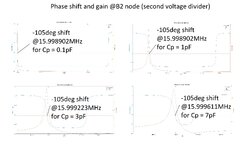miki1221
Newbie level 5

- Joined
- Aug 31, 2024
- Messages
- 9
- Helped
- 0
- Reputation
- 0
- Reaction score
- 0
- Trophy points
- 1
- Activity points
- 69
Can someone explain how we do a AC analysis of harmonic oscillator on following example.
I've done the the 16 Mhz oscillator, and simulated it, but I'm trying to understand how it is really working.

The equivalent circuit is over here(hope so)

So my question is, when I start to analyse by hand on paper, I find problem almost on every step, actually I'm not sure if I'm doing it right, so can someone help me go trough it.
I'm very interested in undarstanding of these and simmilar oscillators so, for you maybe this is quite simple, but I'm new in this so everything seems very complicated for me.
I'll be very appreciate if someone finds time to check and answer my question.
Here are results of DC analysis:
1. Ključni elementi kruga:
Ub=2,5V
Rb=50kΩ
UE=1,8V
IE=1,8mA=IC
UC=3,2V
UCE=1,4V
I've done the the 16 Mhz oscillator, and simulated it, but I'm trying to understand how it is really working.
The equivalent circuit is over here(hope so)
So my question is, when I start to analyse by hand on paper, I find problem almost on every step, actually I'm not sure if I'm doing it right, so can someone help me go trough it.
I'm very interested in undarstanding of these and simmilar oscillators so, for you maybe this is quite simple, but I'm new in this so everything seems very complicated for me.
I'll be very appreciate if someone finds time to check and answer my question.
Here are results of DC analysis:
1. Ključni elementi kruga:
- Ucc: 5 V
- Transistor (Q1): S3018 (NPN)
- R2=100 kΩ
- R3=100 kΩ
- R4=1 kΩ
- R5=1 kΩ
- R6=100Ω
- C16=4.7 nF
- C15=33pF
- C15=33pF
- Kristal:
- XTAL1=16 MHz
- HFE (β): 200
Ub=2,5V
Rb=50kΩ
UE=1,8V
IE=1,8mA=IC
UC=3,2V
UCE=1,4V


